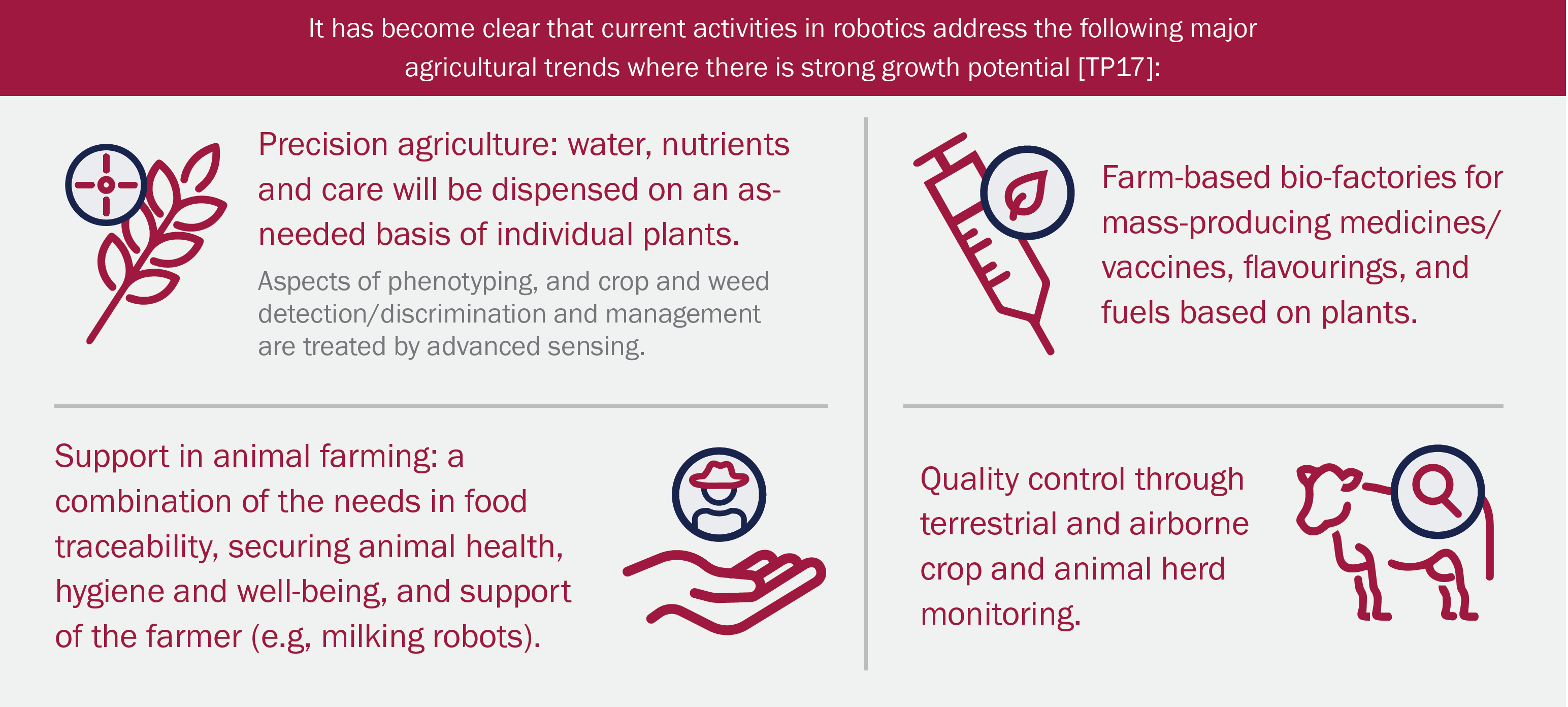
The future of robotics in agriculture, forestry and fisheries
Automated, but manually driven harvesters are already available for different types of agricultural goods. However, except for robots for animal care, livestock and greenhouse automation, service robots have not reached a wider use on a commercial basis. This is due to most applications being dependent on advanced sensor data processing, which is still a challenge in terms of the required dependability in difficult outdoor environmental conditions [TP17].
The opportunities for the Australian agriculture, forestry, and fisheries industries in adopting robotic technologies include safety, attracting young people into a more technologically-advanced workplace, the ability to export into the global AgTech market, more employment opportunities, and improved productivity and sustainability. The application of digital technologies in general results in:
- improved situational awareness – getting intelligence from sensing
- informed decision making for value-chain management
- better and easier compliance with regulation
- access to new markets and business models
- efficiency through automation and autonomy
- an agile innovation pipeline
- requirements for a new (more highly skilled) workforce.
Some current and potential use cases of these technologies include:
- Sensor networks applied within agriculture to tag and track livestock, in aquaculture to measure oyster heartbeats, and to place collars on native pests such as flying foxes.
- Field and crop management – monitoring large outdoor areas to collect real-time high resolution and precise information for efficient use of resources including variable rate application of fertiliser and water, variable seeding etc.
- Weed and pest management – detection and targeting application of specific treatment towards yield increases and further improving Australia’s ‘clean and green’ reputation. Reduction in the cost of management while increasing effectiveness.
- Smaller autonomous ground robots – to replace large machinery achieving reduced soil compaction towards increasing yields, and increasing efficiency through multi-task/field deployment.
- Coordinated heterogeneous multi-robot systems – interfacing between ground and aerial robots including robots for different tasks and from different manufacturers. Additionally, integration with manually operated systems/machinery and other external data sources (e.g; remote sensing).
- Novel decision-support systems and strategies – for site-specific crop management, automation of repetitive tasks, provision of information, and capabilities that benefit the wider supply chain and agricultural researchers.
- Remotely-piloted aircraft – for precision agriculture, biosecurity, environmental monitoring, infrastructure monitoring, and post-disaster surveying.

Robots are an efficient and effective way of deploying sensors to help with resource management. They can provide cost effective pesticide application in agriculture, invasive species management, aerial mapping and infrastructure assessment.
Drones are used by a range of governmental agencies for fishing surveillance, aerial distribution of agricultural chemicals, biosecurity against pest weeds, timber salvage assessments, collection of pest impact imagery, crop biomass sensing, and toward improving farming practices.
Robotics will impact on the sector in two main areas: robot-enabled sensing and robot-enabled acting. Robot-enabled sensing involves using the robots as platforms to carry sensors to collect data and then to use the data for land and water management.
A review of several agriculture industry roadmaps identifies numerous issues now, and in future years, that will directly affect Australia’s ability to meet the growing demand of expanding markets locally and abroad. A number of these issues may be alleviated by introducing robotic and vision technologies. The issues identified include, but are not limited to [TP17]:
- an ageing workforce
- productivity growth and international competitiveness
- soil and water management
- climate change and variability
- conservation of biodiversity
- stagnant R&D investment
- complex IP arrangements
- community perceptions of a ‘sunset’ industry
- farm ownership models
- concerns about foreign investment and labour
- regulatory environments e.g, CASA regulations for UAVs
- biosecurity.
While efficiency is considered an on-going priority for the agricultural industry, the recent CSIRO Future’s Report in Food and Agribusiness [FA17] identified three specific areas that Australian agriculture should target as a means for increasing demand and profit, including:
- products for health and wellbeing
- sustainable solutions
- premium/high end products.
Through selective harvesting and disease/pest treatment, targeted use of water, improvements in efficiency and fast response to consumer demand, robotics can play a role in helping meet these opportunities.
Australia’s Agricultural Future [ACO15] makes an excellent case for introducing robotics and specifically identifies a range of opportunities for robotics and automation, citing technologies implemented in other industries or currently being trialled in agriculture itself. However, concerns exist over the pathways for developing and introducing these technologies including stagnant research funding, complex IP agreements, and enticing the required skilled workforce (see Chapter 2). Growth opportunities for Australia’s food industry include supplying safe, premium meat, fish, dairy, wine, vegetable and processed, branded product to China’s growing middle class.
